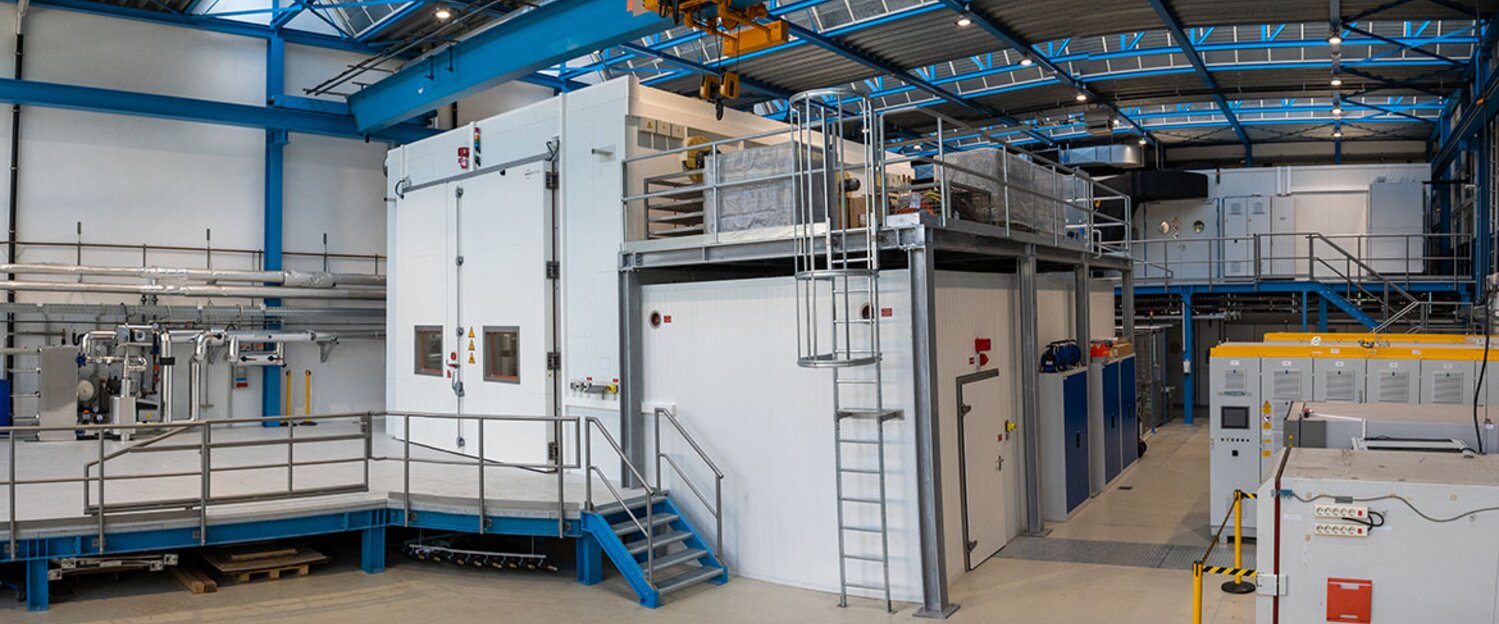WHY – The challenge.
As part of the joint project HiPE-WiND (High Power Electronics in Wind Plants), Bremen University is subjecting wind-power plant inverter systems to long-term tests in collaboration with the Fraunhofer Institute for Wind Energy Systems. The goals are extending the system operating lifetime and preventing downtime. To this end, a drive-in climate chamber was commissioned, in which the ageing of the inverters can be simulated under stress and realistic, varying temperature and climatic conditions. In the decision regarding the provider, the focus was on technical competence. Moreover, the price/performance ratio and the energy efficiency of the system – keywords “green battery” – were of major importance.
At -40°C to +120°C, the required temperature range is very wide. In temperature and climate mode, the test objects generate a high thermal load that must be compensated; the test objects must always have a uniform air flow at a continuous level of performance and heat compensation.
The test space floor is to be set up as a double floor with a load-bearing capacity of at least 10,000 N/m2. The refrigerating unit should be created as environmentally-friendly with a GWP of < 2,500. The system’s noise level must be below 72 dBA.
HOW – The idea.
In order to be able to cope with the up to 5,000 kg test objects, a heavy-load floor made of reversible and perforated double-floor plates was selected. The test chamber itself was planned as a double-walled stainless steel construction and equipped with a 200 mm-thick, 2-layer insulation made of custom foam and mineral wool.
The required temperatures of down to -40°C are achieved efficiently and in an environmentally sound manner using a CO2 cascade cooling system. A CO2 safety concept was developed for this purpose. This includes, for example, standstill refrigeration with a separate power supply to counter excessive system pressure in the event of system standstill; a gas alarm system with visual and acoustic alarm; and emergency purging.
WHAT – The solution.
The test space is 6300x7900x8150 mm (WxDxH) in size, giving it a volume of approx. 190 m3. The adjacent technical room is 4000x7900x3640 mm (WxDxH). The connection value is just under 300 kW.
The large, heavy test objects are driven into the test space through double doors. The heavy-load double floor is set up for a max. 650 N/cm2 point load and 10,000 N/m2 distributed load, meaning that two test objects can be tested simultaneously.
Tests from -40 °C to +120 °C can be conducted in the climatic chamber. The heat compensation in temperature tests is ≥ 50 kW for 85°C/85% RH and ≥ 70 kW for 100 °C/ 95% RH. The humidity range in climatic tests runs from 10 to 95 % RH without heat radiation from the test objects.
Vertical air guidance from underneath through the double floor ensures an especially homogeneous climate distribution in the test space. The circulation fans used are infinitely adjustable. The refrigeration is generated by means of a CO2 cooling cascade in an environmentally-friendly way.
Special construction features
- weisstechnik Turnkey services: Planning, assembly, commissioning, service
- Vapour-proof, corrosion-free stainless-steel climate chambers with CFC-free insulation
- Large-scale, high-performance environmental simulation systems for especially large and heavy test objects
- Environmentally-friendly CO2 refrigeration and CO2 safety concept
- Technical room with separate refrigeration and noise protection for unit

